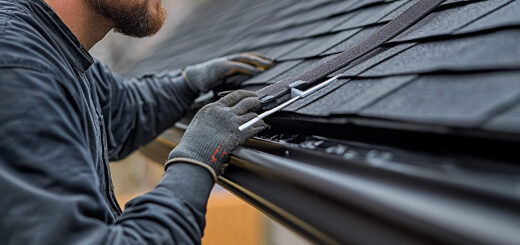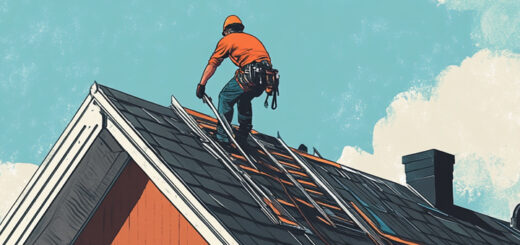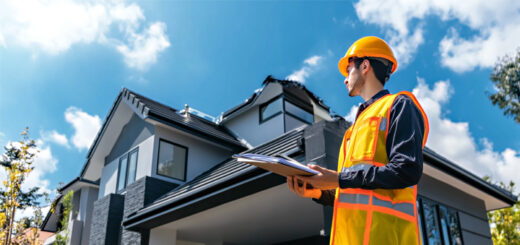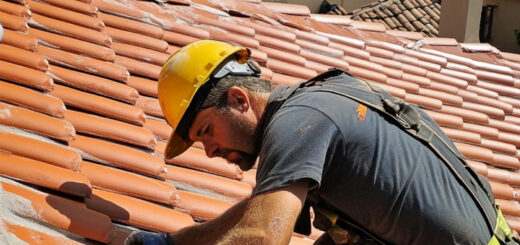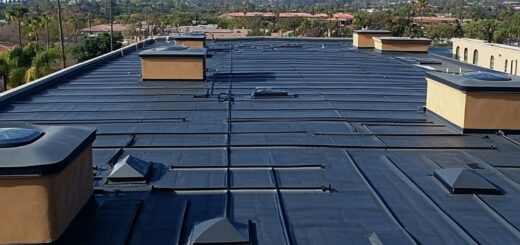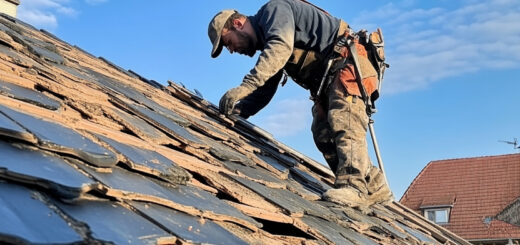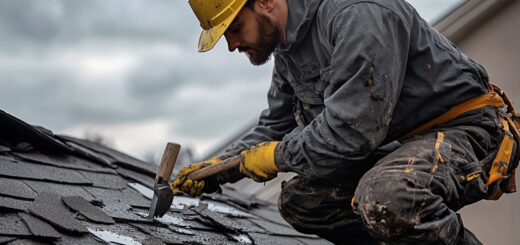Everything You Need to Know About A Roof Replacement
When it comes to maintaining your home, few projects are as crucial as roof replacement. Understanding the importance of roof replacement can not only safeguard your home but also enhance its overall value and efficiency. The roof is a fundamental component that protects your home from the elements, and over time, wear and tear can compromise its integrity.
One of the primary benefits of a new roof is improved protection. A well-maintained roof ensures that rainwater, snow, and debris are kept at bay, preventing potential damage to the structure of your home. Moreover, modern roofing materials offer enhanced durability and energy efficiency compared to older options. This means that by investing in a new roof, you could see significant savings on energy bills due to better insulation.
Another reason why replacing your roof is essential is the boost it provides to your property’s curb appeal. A new roof can dramatically transform the appearance of your home, making it more attractive to potential buyers if you ever decide to sell. Additionally, many homeowners find peace of mind knowing their investment will last for years without requiring frequent repairs.
In conclusion, understanding the importance of roof replacement helps homeowners make informed decisions about when it’s time for an upgrade. The benefits of a new roof extend beyond just aesthetics; they include enhanced protection, increased energy efficiency, and long-term financial savings. Therefore, regularly assessing your roofing needs should be an integral part of home maintenance planning.
Signs That Indicate You Need a Roof Replacement
Recognizing the signs that indicate you need a roof replacement is crucial for maintaining the integrity of your home. One of the primary roof damage signs is persistent leaks. If you notice water stains on your ceilings or walls, it could be a clear indication of a leaking roof that requires immediate attention. Another sign to consider is damaged shingles. Shingles that are cracked, curled, or missing altogether can compromise the effectiveness of your roof and expose it to further damage.
Additionally, if you find granules from shingles in your gutters, this could be an early warning sign that your roofing material is deteriorating and nearing the end of its lifespan. Age is another factor; most roofs last between 20 to 25 years, so if yours falls within this range and exhibits other roofing issues, it might be time for a replacement.
Moreover, sagging areas on your roof can indicate structural problems that need urgent assessment by professionals. Understanding when to replace a roof involves being vigilant about these warning signs and taking proactive measures to ensure the safety and longevity of your home’s structure.
The Roof Replacement Process Explained: What to Expect
Understanding the roof replacement process can help homeowners prepare for what lies ahead, ensuring a smoother and more efficient experience. The process typically begins with a thorough inspection of the current roof to assess its condition and identify any underlying issues that need addressing. This step is crucial as it informs the subsequent stages of replacement.
Once the inspection is complete, selecting the right roofing materials becomes paramount. Options range from traditional asphalt shingles to metal, tile, or slate, each offering distinct advantages in terms of durability, aesthetics, and cost. Consulting with a roofing professional can provide valuable insights into which material best suits your home’s needs and climate conditions.
The actual replacement starts with removing the old roofing materials to expose the roof deck. This allows for an evaluation of any damage that may not have been visible during initial inspections. Necessary repairs to the deck are made at this stage to ensure a solid foundation for the new roof.
Next comes installing underlayment—a waterproof barrier that protects against moisture intrusion—followed by laying down new shingles or tiles according to your chosen materials. Proper installation techniques are critical here to ensure longevity and performance.
Finally, once all materials are in place, a final inspection ensures everything meets quality standards and local building codes. Understanding these steps in replacing a roof helps demystify how roofs are replaced and prepares homeowners for each phase of this essential home improvement project.
Cost Factors and Budgeting for a New Roof
When planning for a new roof, understanding the cost factors and budgeting effectively are crucial steps. The roof replacement cost estimate can vary significantly based on several key elements. One of the primary factors affecting roofing costs is the type of materials chosen. Options range from asphalt shingles to metal roofing, each with its own price point and longevity considerations.
Labor costs also play a significant role in the overall budget. Depending on your location and the complexity of your roof’s design, labor expenses can fluctuate. Additionally, any necessary removal of old roofing materials will add to this component.
Another factor to consider is the size and pitch of your roof. Larger roofs or those with steep pitches require more materials and labor, thus increasing costs. It’s also important to account for any additional features such as skylights or chimneys that may require special attention during installation.
Effective roofing budget planning involves not only accounting for these direct costs but also setting aside funds for unexpected expenses that might arise during the project. By thoroughly researching these aspects and obtaining multiple quotes from reputable contractors, you can create a comprehensive budget that ensures you’re well-prepared for your new roofing project without financial surprises.
Selecting the Right Roofing Contractor for Your Project
When it comes to selecting the right roofing contractor for your project, making an informed decision is crucial. The roof is a significant investment in your home, and ensuring you choose a reliable and skilled roofer can save you time, money, and stress in the long run.
Start by researching potential candidates thoroughly. Look for roofing companies with strong reputations in your community. Online reviews and testimonials can provide valuable insights into their reliability and quality of work. Additionally, ask friends or family for recommendations if they have recently had roofing work done.
Once you’ve identified a shortlist of potential contractors, it’s essential to have a set of questions ready to evaluate them further. Key questions to ask include: Are you licensed and insured? Can you provide references from recent projects? What warranties do you offer on materials and workmanship? How do you handle unforeseen issues or additional costs?
Finding reliable roofing companies also involves checking their credentials. Verify that they hold the necessary licenses required by state or local authorities. Insurance is equally important as it protects both parties in case of accidents during the project.
By taking these steps—choosing a roofer carefully, asking critical questions, and verifying credentials—you can ensure that your roofing project is handled by professionals who will deliver quality results tailored to your needs.
The Benefits of Different Roofing Materials and Styles
When it comes to choosing the right roofing material for your home, understanding the benefits of each option is crucial. The variety of types available—ranging from asphalt shingles to metal roofs, tiles, slate, and wood shakes—offers homeowners flexibility in both style and function.
Asphalt shingles are a popular choice due to their affordability and ease of installation. They provide reliable protection against various weather conditions and come in a range of colors and styles to match any home aesthetic. However, they typically have a shorter lifespan compared to other materials.
Metal roofs are known for their durability and longevity, often lasting upwards of 50 years with minimal maintenance. They are also energy-efficient, reflecting solar radiant heat which can reduce cooling costs significantly. Metal roofing options include aluminum, steel, copper, and zinc—all offering unique advantages depending on environmental needs.
Tiles offer a classic look with exceptional durability. Available in clay or concrete forms, tile roofs are fire-resistant and can withstand harsh weather conditions while providing excellent insulation properties. However, they tend to be heavier than other materials and may require additional structural support.
Slate is one of the most long-lasting roofing materials available today—often enduring over a century when properly maintained. Its natural appearance adds an elegant touch to any property while offering superior resistance against fire and water damage. Slate’s weight also requires careful consideration regarding roof structure support.
Wood shakes present an attractive rustic appeal that blends seamlessly with natural surroundings. Made from cedar or redwood trees, wood shakes offer decent insulation properties but require regular maintenance to prevent issues like mold or insect infestation.
Each type of roofing material offers distinct advantages depending on your specific needs—from cost considerations to aesthetic preferences—and understanding these benefits will help ensure you make an informed decision for your home’s roof replacement or installation project.
Caring for Your New Roof: Maintenance Tips and Tricks
Caring for your new roof is essential to ensure it stands the test of time and continues to protect your home effectively. By following some key maintenance tips, you can extend the lifespan of your roof and avoid costly repairs down the line.
One of the most important aspects of maintaining new roofs is conducting regular inspections. It’s advisable to inspect your roof at least twice a year, ideally in spring and fall, to check for any signs of damage such as missing shingles or leaks. Catching these issues early can prevent them from escalating into more significant problems.
Cleaning gutters is another crucial component of roof maintenance. Gutters that are clogged with leaves and debris can cause water to back up, leading to potential water damage on the roof itself or even inside your home. Make it a habit to clean out gutters regularly, especially during seasons when foliage is abundant.
Additionally, consider trimming overhanging branches near your roof. Branches that hang too close can scrape against shingles during windy conditions or break off entirely during storms, causing direct damage.
By incorporating these simple yet effective roof maintenance tips into your routine, you’ll be well on your way to maintaining a sturdy and reliable roof that serves you well for many years.
Making Informed Decisions on Your Roof Replacement Journey
Concluding your roof replacement journey involves making informed decisions that will impact the longevity and performance of your home. It is crucial to consider various factors such as the type of materials, the expertise of contractors, and budget constraints. By thoroughly researching different roofing materials, homeowners can choose options that not only fit their aesthetic preferences but also offer durability and weather resistance suitable for their specific climate conditions. Additionally, selecting a reputable contractor with a proven track record ensures quality workmanship and adherence to safety standards. Budgeting for unexpected expenses can prevent financial stress during the project and allow for any necessary adjustments without compromising on quality. Ultimately, making informed decisions in each step of the roof replacement process not only enhances the structural integrity of your home but also contributes to long-term value and peace of mind.


